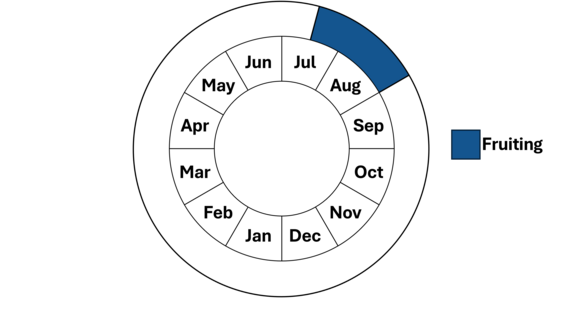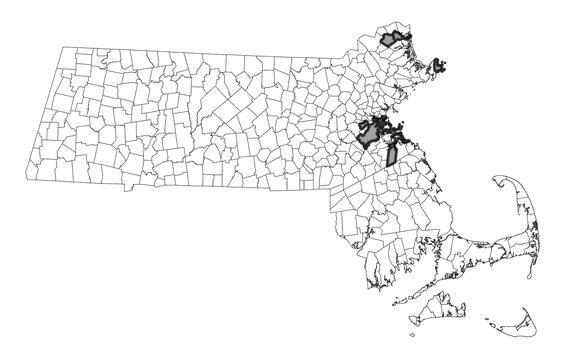- Scientific name: Rumex pallidus Bigelow
- Species of Greatest Conservation Need (MA State Wildlife Action Plan)
- Threatened (MA Endangered Species Act)
Description
Seabeach dock, Rumex pallidus, a member of the Buckwheat family (Polygonaceae), is a medium-sized, herbaceous perennial with conspicuous branched racemes of many, small, crowded, greenish flowers. It grows from 2-7 dm (8 in-2.3 ft) high, and its branched stem grows either obliquely upwards or reclines on the ground before ascending. Unlike most members of the genus Rumex, seabeach dock has leaves that are glaucous (having a whitish, waxy covering). These narrowly lanceolate leaves give the species its alternate common name of white dock. Its small, greenish, frequently red-tinged flowers are each held on a jointed flower stalk. The plump, whitish achenes (dry, one-seeded fruits that retain their seeds) are nearly as long as the achene wings. Seabeach dock fruits from mid-July to late September.
Curly dock (Rumex crispus) often occurs with seabeach dock. However, R. crispus has wavy-edged leaves. It also has one large and two small achenes per flower, in contrast to the three similar achenes of R. pallidus. Willow-leaf dock (Rumex triangulivalvis, which also has "white dock" as another common name) is often found in the same habitat and can be easily confused with seabeach dock. Willow-leaf dock has inner tepals with a narrow tubercle which is less than 1/2 as wide as its associated tepal. The tubercle is much shorter than the tepal. In addition the leaf blades are only 5 to 6 times as long as wide. Seabeach dock has a tubercle more than half as wide and nearly as long as its associated tepal. Its leaf blades are mostly 7 to 10 times as long as wide (Haines 2011).
Life cycle and behavior
This is a perennial species.

Population status
Seabeach dock is listed under the Massachusetts Endangered Species Act as threatened. All listed species are protected from killing, collecting, possessing, or sale and from activities that would destroy habitat and thus directly or indirectly cause mortality or disrupt critical behaviors. There are currently 8 occurrences in the state verified since 1999 found in Essex, Norfolk, and Suffolk Counties.
Distribution and abundance
Seabeach dock is known in the northeastern Canadian provinces south to Massachusetts and New York. It is possibly extirpated from New York and Vermont, critically imperiled in Prince Edward Island and New Hampshire, imperiled in Labrador and Massachusetts and vulnerable in New Brunswick, Newfoundland, Nova Scotia and Quebec.

Distribution in Massachusetts
1999-2024
Based on records in the Natural Heritage Database
Habitat
Seabeach dock is a plant of beaches and coastal swamps. Itshabitats in Massachusetts include upper beaches with cobble, cobble and gravel, shale and shell, or gravelly sand substrates. Somewhat atypically, a station also occurs on a cobbly, exposed flat shore of the Merrimack River. Associated species include seaside goldenrod (Solidago sempervirens), curly dock (Rumex crispus), beach pea (Lathyrus japonicus), wrinkled rose (Rosa rugosa), and dunegrass (Elymus mollis).
Healthy habitats are vital for supporting native wildlife and plants. Explore habitats and learn about conservation and restoration in Massachusetts.
Threats
In part, seabeach dock is rare here because Massachusetts is near the southernmost edge of its range so could be significantly impacted by climate change. Nevertheless, heavy use of beaches by people and their vehicles poses a threat to seabeach dock.
Conservation
Seabeach dock should be protected from trampling though access limits to its habitat. Other management needs need to be identified.
References
Gleason, Henry A., and Arthur Cronquist. Manual of Vascular Plants of Northeastern United States and Adjacent Canada, Second Edition. Bronx, NY: The New York Botanical Garden, 1991.
Haines, A. 2011. Flora Novae Angliae – a Manual for the Identification of Native and Naturalized Higher Vascular Plants of New England. New England Wildflower Society, Yale Univ. Press, New Haven, CT.
NatureServe. 2025. NatureServe Network Biodiversity Location Data accessed through NatureServe Explorer [web application]. NatureServe, Arlington, Virginia. Available https://explorer.natureserve.org/. Accessed: 5/27/2025.
POWO (2025). Plants of the World Online. Facilitated by the Royal Botanic Gardens, Kew. Published on the Internet; https://powo.science.kew.org/ Accessed: 5/27/2025.
Staudinger, M.D., A.V. Karmalkar, K. Terwilliger, K. Burgio, A. Lubeck, H. Higgins, T. Rice, T.L. Morelli, A. D'Amato. 2024. A regional synthesis of climate data to inform the 2025 State Wildlife Action Plans in the Northeast U.S. DOI Northeast Climate Adaptation Science Center Cooperator Report. 406 p. https://doi.org/10.21429/t352-9q86
Contact
| Date published: | May 8, 2025 |
|---|